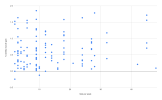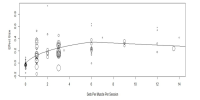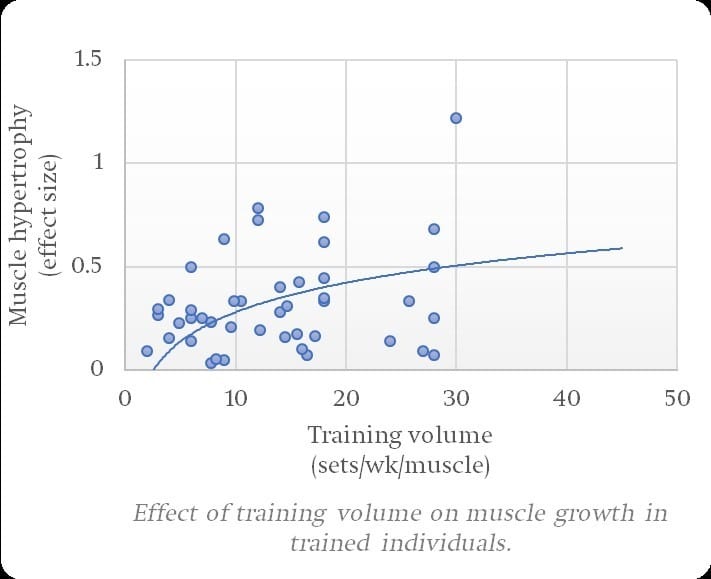Hello everyone, my name is Ignacio and this is my first post on the forum. Glad to meet you all.
In the last few years there has been a number researchers arguing for the dose-response relationship between training volume and muscle hypertrophy, even a published paper calls Volume The Most Effective Variable in Resistance Training.
I personally thought all these researchers must be right, they are of course the experts on the topic, but nonetheless I decided to do some research myself.
One point I got from a podcast interview with Bryan Haycock was that any reasonable resistance training program will get you to your genetic potential eventually, but better programs will get you there faster. So, why not investigate if higher volume of training has an effect on the rate of muscle hypertrophy?
This is what I came up with:

I took 24 studies and divided the final muscle gain by the numbers of weeks. (Those far up right are from the Schoenfeld volume study and are 3 SD away from the mean, which would gives us an indication that the measurements were probably confounded by something, like edema for example). EDIT = I made a mistake when doing the calculations of Schoenfeld's study, the results are within a SD.
As you can probably tell, there is no apparent dose-response relationship between training volume and rate of muscle hypertrophy.
IMHO, those arguing for a dose-response relationship make some unsubstantiated assumptions with their research:
Enough of my rambling, I would like to hear your thoughts on the matter.
I leave with a quote from a Ralph Carpinelli article:
"What do the advocates of the more-is-better philosophy mean by a greater number of sets-greater than what? Berger (1962) reported a 3% difference in strength after performing 300% more exercise using three sets compared with one set. Will six sets (600% more exercise) elicit a 6% greater increase in strength? Will ten sets (1000% more exercise) produce a 10% greater increase? Will 100 sets (10,000% more exercise) produce twice as much strength as one set? Is there a volume limit? What do the authors mean by a greater number of repetitions-20 reps, 100 reps, 1000 reps? What are the physiological mechanisms involved with a greater volume of exercise that would stimulate greater muscular size or strength? These are questions that are never addressed by those with the more-is-better mentality."
Best Regards
In the last few years there has been a number researchers arguing for the dose-response relationship between training volume and muscle hypertrophy, even a published paper calls Volume The Most Effective Variable in Resistance Training.
I personally thought all these researchers must be right, they are of course the experts on the topic, but nonetheless I decided to do some research myself.
One point I got from a podcast interview with Bryan Haycock was that any reasonable resistance training program will get you to your genetic potential eventually, but better programs will get you there faster. So, why not investigate if higher volume of training has an effect on the rate of muscle hypertrophy?
This is what I came up with:

I took 24 studies and divided the final muscle gain by the numbers of weeks. (Those far up right are from the Schoenfeld volume study and are 3 SD away from the mean, which would gives us an indication that the measurements were probably confounded by something, like edema for example). EDIT = I made a mistake when doing the calculations of Schoenfeld's study, the results are within a SD.
As you can probably tell, there is no apparent dose-response relationship between training volume and rate of muscle hypertrophy.
IMHO, those arguing for a dose-response relationship make some unsubstantiated assumptions with their research:
- You need higher volume to reach your genetic potential. NO EVIDENCE TO SUPPORT THIS.
- Trained trainees require more training volume to keep on gaining muscle. NO EVIDENCE TO SUPPORT THIS.
- It is possible for a trained athlete to keep gaining muscle at the same rate that a beginner. NO EVIDENCE TO SUPPORT THIS.
- You can keep on gaining muscle even when you are very advanced. NO EVIDENCE TO SUPPORT THIS.
Enough of my rambling, I would like to hear your thoughts on the matter.
I leave with a quote from a Ralph Carpinelli article:
"What do the advocates of the more-is-better philosophy mean by a greater number of sets-greater than what? Berger (1962) reported a 3% difference in strength after performing 300% more exercise using three sets compared with one set. Will six sets (600% more exercise) elicit a 6% greater increase in strength? Will ten sets (1000% more exercise) produce a 10% greater increase? Will 100 sets (10,000% more exercise) produce twice as much strength as one set? Is there a volume limit? What do the authors mean by a greater number of repetitions-20 reps, 100 reps, 1000 reps? What are the physiological mechanisms involved with a greater volume of exercise that would stimulate greater muscular size or strength? These are questions that are never addressed by those with the more-is-better mentality."
Best Regards
Attachments
Last edited:





